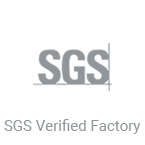Foam tapes are widely used in various industrial and consumer product fields, especially in sealing, cushioning, sound absorption, shockproofing, etc. According to the different internal structures of foam and the different foaming processes, foam tapes are mainly divided into two categories: open-cell foam tapes and closed-cell foam tapes. So what is the difference between open cell vs closed cell foam tapes?
The difference between the two is not only reflected in the physical structure, but also in their application, performance and material properties. In order to help users choose suitable products, Shanghai Toptape will elaborate on the difference between open-cell foam tapes and closed-cell foam tapes from multiple aspects such as the definition, structural differences, material properties, performance parameters, application scenarios, and selection guidelines of the two products. Let’s learn about it together.
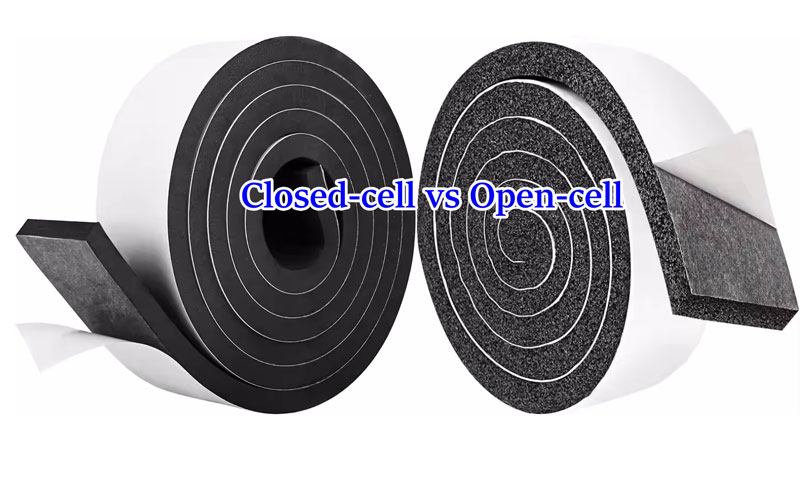
1.Definition and structural overview of foam tape
Foam tape is a tape with adhesive coated on a foam substrate. It usually has strong adhesion and can be applied to various irregular surfaces. Foam itself has elasticity and cushioning properties, so it is widely used in industrial production, building assembly, electronic equipment, home decoration and other fields.
Foam materials are divided into two categories according to the bubble structure: open-cell and closed-cell:
- Open-cell structure: The bubbles inside the foam are connected to each other, and gas and liquid can flow freely through the foam structure. This structure gives the foam good air permeability and water absorption.
- Closed-cell structure: The bubbles inside the foam are closed, and gas and liquid cannot pass through. This structure gives the foam good sealing, waterproof and heat insulation.
2. Detailed analysis of open-cell foam tape
Open-cell foam tape uses open-cell foam as the base material, and the bubbles of the foam are connected to each other, giving it air permeability and sound absorption properties. This tape is soft, light and compressible, and is suitable for applications that require sound absorption and breathability.

2.1 Material properties:
- Air permeability: Because the bubbles are open, air can flow freely, making the open-cell foam have high air permeability.
- Water absorption: The open-cell structure enables the foam to absorb a large amount of water, so it has good water absorption performance.
- Sound absorption performance: Open-cell foam can effectively absorb sound and reduce noise transmission, so it is often used in sound insulation materials.
- Softness: Open-cell foam is usually soft, easy to compress and has good recovery performance.
2.2 Application areas of open-cell foam tape:
- Sound absorption material: Due to its excellent sound absorption effect, open-cell foam tape is often used in the walls and ceilings of buildings to reduce noise transmission. In addition, such materials are also widely used in the sound insulation structure of automobiles and electronic products.
- Buffer material: The softness of open-cell foam makes it a good buffer material. It is often used in electronic equipment, household items and packaging materials to reduce shock and protect fragile items.
- Filter and breathable applications: Due to its good breathability, open-cell foam tape can be used as a filter material in air filtration systems, or in parts of equipment that need to be breathable but also need a certain degree of protection.
- Cleaning tools: Open-cell foam has strong water absorption performance and is often used in various cleaning tools, such as dishcloths, absorbent sponges, etc.
- Medical supplies: Due to its good air permeability and water absorption, open-cell foam is often used in medical supplies such as bandages, dressings and bandages.

2.3 Advantages and disadvantages of open-cell foam tape:
2.3.1 Advantages:
- Good air permeability, suitable for occasions where air circulation is required.
- Excellent sound absorption, suitable for sound insulation needs.
- Good water absorption, suitable for environments with high humidity.
2.3.2 Disadvantages:
- Because of its strong water absorption, it is easy to absorb moisture and expand in a humid environment.
- Poor sealing, unable to provide good waterproof effect.
- Under strong pressure, the durability of open-cell foam is not as good as closed-cell foam.
3. Detailed analysis of closed-cell foam tape
Closed-cell foam tape uses closed-cell foam as the base material, and its internal bubbles are independently closed and not connected to the outside world. This structure gives it better waterproof, moisture-proof, heat-insulating, sealing and cushioning properties. Closed-cell foam tape has strong sealing and performs particularly well in high humidity or high-demand environments.
3.1 Material properties:
- Waterproofness: The bubbles of closed-cell foam are closed, and moisture cannot enter them, so it has strong waterproof properties.
Heat insulation: Closed-cell foam can effectively block the conduction of heat and is often used in thermal insulation materials. - Compressibility and resilience: Closed-cell foam can quickly return to its original shape after compression, and has high compressive resistance.
- Insulation performance: Closed-cell foam has good electrical insulation performance and can be used in occasions requiring electrical isolation.
- Chemical corrosion resistance: Closed-cell foam has good tolerance to chemicals such as acids and alkalis, and is suitable for chemical environments.
3.2 Application areas of closed-cell foam tape:
- Sealing materials: Closed-cell foam tape is widely used in parts that require waterproofing and sealing in automobiles, buildings, home appliances, etc., such as car window seals, door and window waterproof seals, and protective seals for electrical equipment.
- Insulation materials: Closed-cell foam is often used in insulating parts of electronic equipment to prevent current leakage due to its excellent electrical insulation performance.
- Shockproof and cushioning materials: The high density and high resilience of closed-cell foam make it an excellent shockproof material, which is widely used in shockproof packaging of industrial equipment, precision instruments and electronic equipment.
- Insulation materials: Closed-cell foam has excellent thermal insulation performance and is often used in building insulation materials or thermal insulation layers of industrial equipment. It can effectively reduce energy loss and save energy.

3.3 Advantages and disadvantages of closed-cell foam tape:
3.3.1 Advantages:
- Excellent sealing performance, suitable for environments requiring high waterproofness and sealing.
- Good thermal insulation effect, suitable for heat preservation and cold insulation occasions.
- High-density foam has good durability and can withstand high-intensity pressure.
- Strong corrosion resistance, suitable for use in chemical environments.
3.3.2 Disadvantages:
Not breathable, cannot be used in environments requiring air circulation.
Poor sound absorption performance, not suitable for use as sound-absorbing material.
4. Detailed comparative analysis of open cell vs closed cell foam tapes
- Material structure: The bubbles of open-cell foam are connected, with high air permeability and water absorption, while the bubbles of closed-cell foam are closed, with significant waterproof and moisture-proof effects.
- Sealing performance: The sealing performance of closed-cell foam tape is significantly better than that of open-cell foam tape, and it is suitable for applications that require waterproofing and sealing.
- Sound absorption effect: Open-cell foam tape can effectively absorb and attenuate sound waves due to its interconnected bubble structure, and has a significant sound absorption effect; while closed-cell foam has poor sound absorption due to the closed bubbles.
- Thermal insulation performance: The bubble structure of closed-cell foam tape can effectively isolate heat conduction, and has excellent thermal insulation performance, making it suitable for thermal insulation materials; open-cell foam has poor thermal insulation performance due to its strong air permeability.
- Compression and resilience: The compression and resilience of closed-cell foam tape are better than those of open-cell foam, especially when subjected to long-term pressure, the recovery performance of closed-cell foam is better.
- Water resistance: Closed-cell foam tape has excellent waterproof effect due to its closed bubble structure, and water cannot enter; open-cell foam has strong water absorption and is not suitable for humid environments.
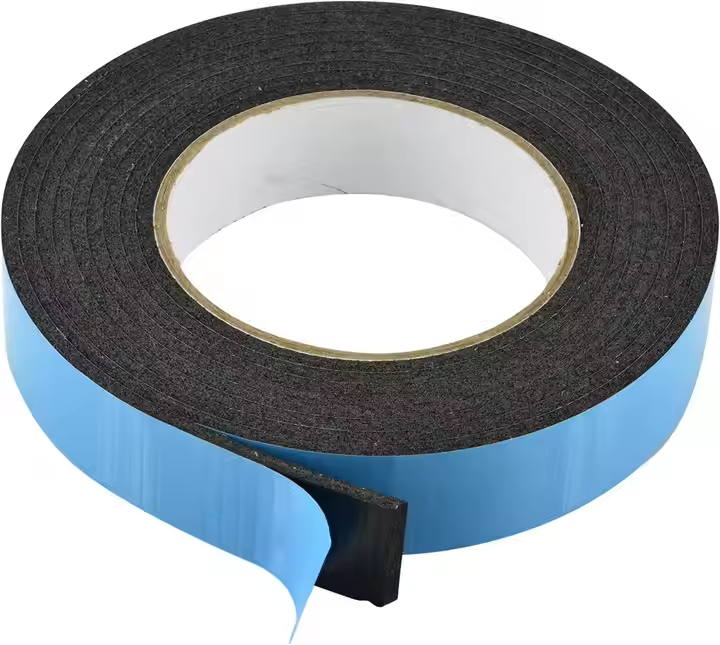
5. Comparison of professional data parameters
In order to more intuitively show the performance differences between the two foam tapes, the following is a comparison of some common performance parameters of open-cell foam and closed-cell foam:
| Performance Parameters | Open-Cell Foam Adhesive Tape | Closed-Cell Foam Adhesive Tape |
|---|---|---|
| Density | 30-60 kg/m³ | 60-100 kg/m³ |
| Water Absorption Rate | 50-90% | ≤3% |
| Tensile Strength | 50-150 kPa | 100-300 kPa |
| Compression Strength | 25-70 kPa | 50-200 kPa |
| Resilience | Medium | High |
| Sound Absorption Coefficient | 0.3-0.8 | 0.05-0.2 |
| Thermal Insulation Coefficient | 0.035-0.04 W/mK | 0.03-0.035 W/mK |
6. Selection Guide and Usage Recommendations
When choosing foam tape, users should decide whether to use open-cell foam or closed-cell foam according to specific application requirements:
- If good sound absorption, air permeability or water absorption performance is required, it is recommended to choose open-cell foam tape.
- If the application environment has high requirements for waterproofing, moisture resistance, heat insulation and sealing, it is recommended to choose closed-cell foam tape.
In addition, users can also make detailed choices based on the following points:
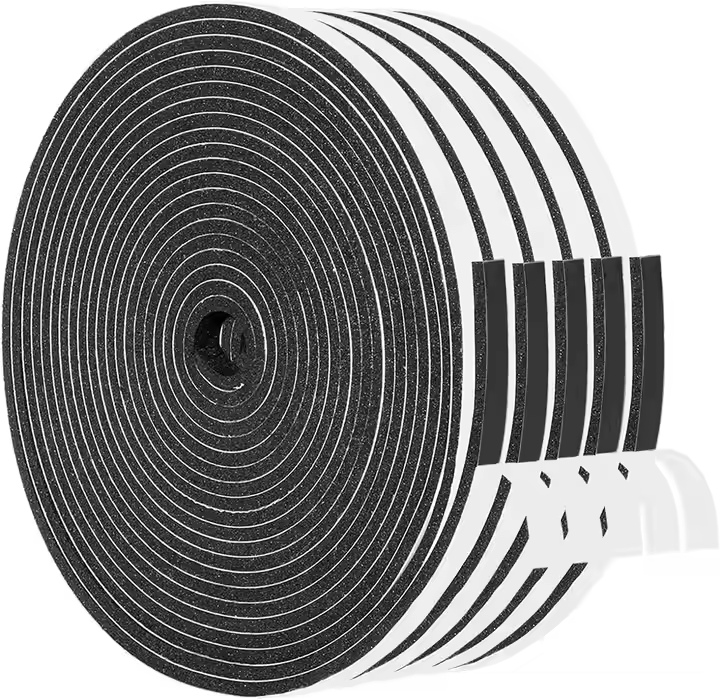
6.1 Environmental factors:
- If the application environment has high humidity or needs to be in contact with water for a long time, such as building door and window sealing, automobile sealing strips, etc., choosing closed-cell foam tape is the best choice. Closed-cell foam has excellent waterproof performance and can effectively avoid performance loss and tape deformation caused by moisture.
- For dry environments, especially scenes that require a certain degree of air permeability or sound absorption, such as home decoration, wall sound insulation, etc., you can consider using open-cell foam tape.
6.2 Sound absorption requirements:
- If the application field involves noise control, sound absorption and other requirements, such as office and conference room sound insulation projects, it is recommended to use open-cell foam tape, which can effectively reduce the propagation of sound waves through internally connected bubbles and provide better sound absorption effects.
- On the contrary, if there are no special requirements for sound absorption, but there are high requirements for waterproofing and sealing, closed-cell foam tape is more suitable.
6.3 Sealing requirements:
The sealing performance of closed-cell foam tape is much better than that of open-cell foam tape, and it is particularly suitable for scenes with high sealing requirements, such as sealing strips in automobile manufacturing, waterproof and heat insulation devices for industrial equipment, etc.
6.4 Durability requirements:
Under long-term pressure, closed-cell foam tape performs better due to its high resilience and compressive resistance, and is suitable for applications that require durability and high-density foam. Open-cell foam tape is usually used in lightweight occasions that do not require long-term pressure.
6.5 Shockproof and cushioning performance:
Due to its high density and good elasticity, closed-cell foam tape is usually used in scenarios requiring shockproof and shock-absorbing, such as shockproof packaging for precision instruments and cushioning pads in electronic equipment. Although open-cell foam tape has excellent softness, it is not suitable for long-term exposure to severe external forces.
6.6 Temperature and chemical environment:
- If the foam tape needs to work in extreme temperatures or chemical environments, closed-cell foam tape is more suitable due to its excellent high temperature resistance and chemical tolerance. Closed-cell foam has strong tolerance to acids, alkalis, solvents, etc., and is widely used in the chemical, construction and electronics industries.
- Open-cell foam tape is more suitable for sound absorption and breathable occasions in general environments, and is not suitable for use in extreme temperatures or highly corrosive environments.
7. Innovation and development of foam tape and future trends
With the advancement of material technology and the continuous changes in market demand, the performance and application areas of foam tape are also expanding. In the future, foam tapes will develop towards higher performance, more environmentally friendly and wider applications:
- Research and development of high-performance foam: With the development of science and technology, manufacturers are constantly developing new high-performance foam materials. In the future, foam tapes will not be limited to the existing open-cell and closed-cell foams. There may be mixed-structure foams, such as partially open-cell and partially closed-cell mixed foams, to meet more diversified needs. This new structure can provide certain air permeability and sound absorption while maintaining high sealing and waterproof performance.
- The rise of environmentally friendly foam materials: Environmental issues are increasingly receiving global attention, and the production of foam materials is also developing in an environmentally friendly direction. In the future, foam tapes may use more degradable or recyclable materials to reduce the impact on the environment. At the same time, the manufacturing process of foam is also constantly improving to reduce energy consumption and pollutant emissions in the production process.
- Application of smart foam materials: With the advancement of smart material technology, foam materials are expected to be given more intelligent functions. For example, foam can automatically adjust its sealing or elasticity through changes in the external environment (such as temperature and pressure) to adapt to different application requirements. Such smart foam materials will further expand the application of foam tapes in industrial and consumer fields.
- Multifunctional composite foam tape: In the future, foam tapes may be combined with other materials to form composite materials with multiple functions. For example, the combination of foam and conductive materials can form a tape with both cushioning properties and conductive functions; the combination of foam and antibacterial materials can be used for antibacterial sealing of medical devices, etc.
- Automated processing and customized production: With the development of Industry 4.0 and intelligent manufacturing, the production of foam tapes will be more automated and intelligent, and customized production will become a trend. Customers will be able to customize foam tapes with different performance, specifications and uses according to specific needs. This customized production model will greatly improve the application efficiency of foam tapes and reduce unnecessary waste.
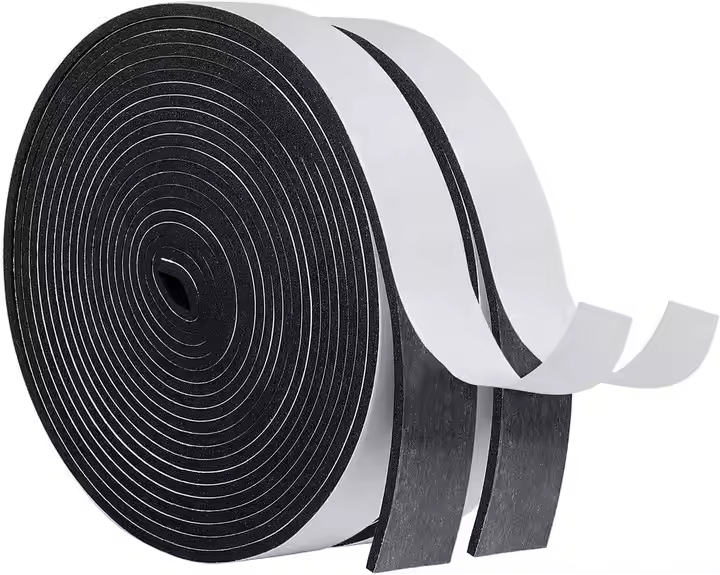
9. Conclusion
Through a detailed analysis of open-cell foam tapes and closed-cell foam tapes, it can be seen that there are significant differences between the two in terms of structure, material properties, application fields and performance. Open-cell foam tape is widely used in scenes that require sound absorption and breathability due to its excellent air permeability, sound absorption and water absorption performance; while closed-cell foam tape has become the first choice for high-demand fields such as industrial sealing, shockproofing, and insulation due to its strong waterproof, moisture-proof, heat-insulating and sealing performance.
When choosing foam tape, users should reasonably choose suitable products according to specific application requirements, such as environmental conditions, sealing requirements, sound absorption effects, shockproof performance, etc. At the same time, with the advancement of science and technology, foam tape will continue to innovate in material performance, environmental protection and intelligence in the future, providing efficient and reliable solutions for more fields.
10. Appendix: Common specifications and parameters of open-cell and closed-cell foam tapes
For the convenience of users to choose, the following are some common specifications and technical parameters of open-cell foam tapes and closed-cell foam tapes:
| Parameter Name | Open-Cell Foam Adhesive Tape | Closed-Cell Foam Adhesive Tape |
|---|---|---|
| Material | PU Foam, PE Foam, EVA Foam | PVC Foam, EVA Foam, PE Foam |
| Thickness Range | 0.5mm – 10mm | 1mm – 50mm |
| Density | 30-60 kg/m³ | 60-150 kg/m³ |
| Tensile Strength | 50-150 kPa | 100-300 kPa |
| Water Absorption Rate | 50-90% | ≤3% |
| Operating Temperature Range | -30℃ to 100℃ | -40℃ to 120℃ |
| Resilience | Medium | High |
| Common Applications | Soundproofing, Filtration | Sealing, Waterproofing |
By comparing these technical parameters, users can further refine their selections according to their needs to find the foam tape product that best suits their application.
If you are looking for foam tape for different uses, welcome to contact Shanghai Toptape! We will provide a complete adhesive tape solution!





